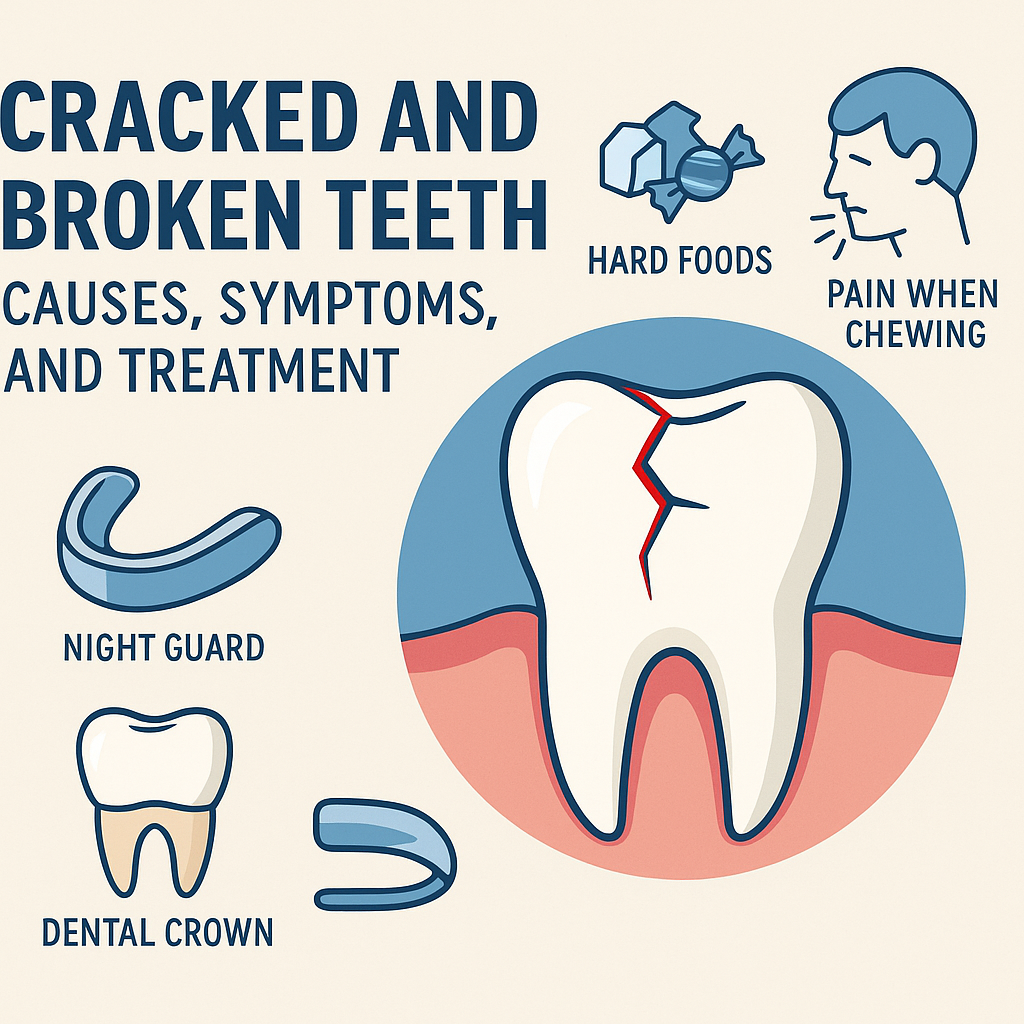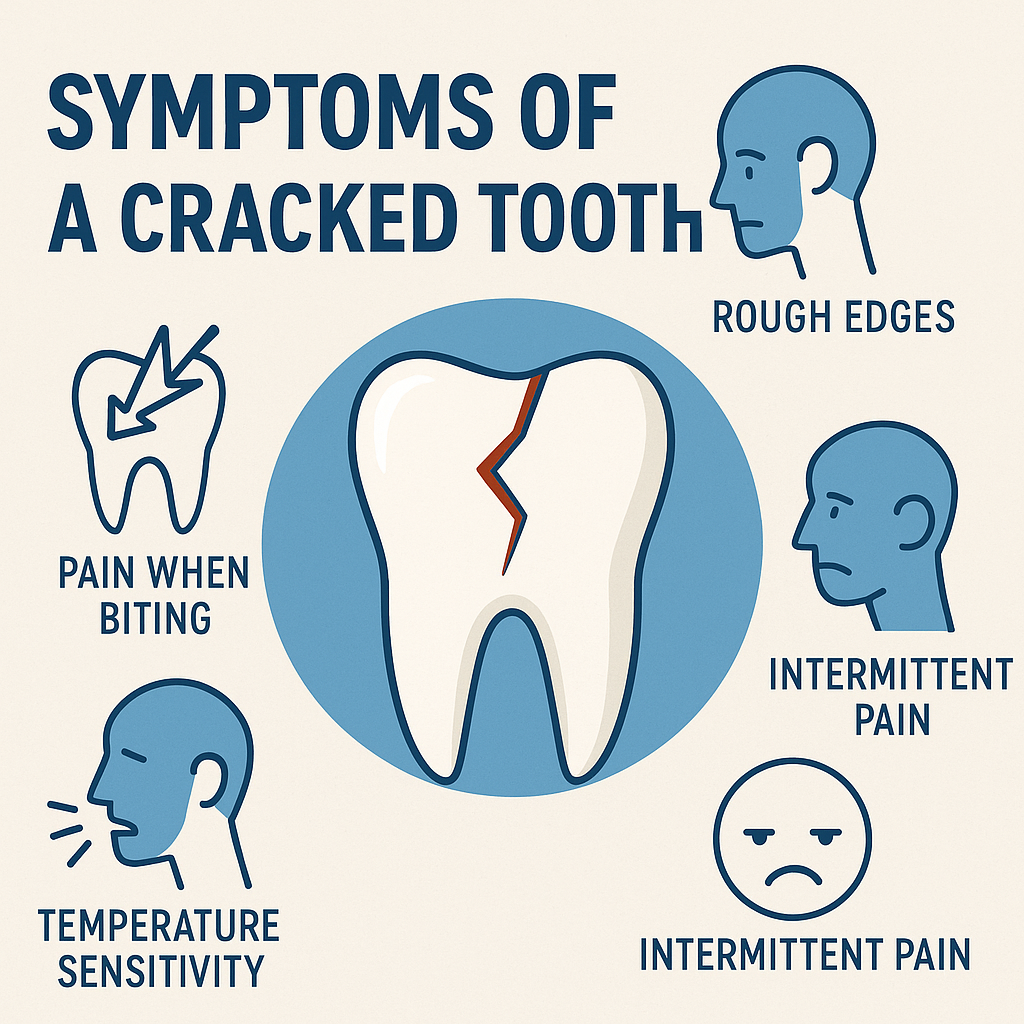Introduction
Teeth are fracturing more than ever and are now the third leading cause of tooth loss. This rise comes from longer life spans and increased stress. Older teeth are more brittle, and stress leads to clenching and grinding. Teeth may also crack from temperature changes, trauma, or everyday habits. Night-time grinding (bruxism) especially raises the risk of cracks and fractures. Wearing a night guard is one of the most effective ways to protect against damage caused by grinding.
Teeth cracking is a growing concern due to modern lifestyles.
Craze lines, also known as hairline cracks, are tiny cracks that occur in the outer enamel of all adult teeth. These cracks affect only the outer enamel and are typically harmless, usually requiring no treatment unless they worsen or cause concern.
Cracked tooth syndrome is a condition where a tooth develops a small, often hidden crack that can cause discomfort. Cracking can result from hard foods, grinding, or trauma. Many people feel pain or sensitivity when chewing, especially as the crack worsens. If left untreated, the tooth may develop decay, infection, or even be lost. Since symptoms often begin subtly, it’s important to see a dentist promptly if you notice discomfort. Early care can stop the crack from spreading and protect your oral health.
Common Causes of Tooth Fractures
Tooth fractures happen for several reasons:
- Hard food such as ice, nuts, lollies, or popcorn kernels
- Grinding or clenching (bruxism), especially at night
- Trauma from accidents, falls, or sports injuries
Biting or chewing on hard food can cause a tooth to break or start cracking.
These causes weaken the enamel and can open pathways for cracks to spread deeper into the tooth.
Taking steps to prevent accidents can help reduce the risk of tooth fractures.
Lifestyle and Risk Factors for Cracks
Everyday factors also play a role. Large fillings can weaken the remaining tooth structure, making fractures more likely. Gum recession exposes the roots and leaves the gums more vulnerable, which are more fragile than enamel. Chewing on hard objects like pens or fingernails puts repeated stress on teeth. Over time, general wear and tear on teeth can also increase the risk of cracks.
Being mindful of these risks, and wearing a protective mouthguard during contact sports, helps protect the mouth from injury and lowers the chance of developing a cracked or broken tooth.

Types of Tooth Damage
Tooth damage appears in different stages, ranging from harmless to severe:
- Craze lines – tiny cracks in the enamel, also known as hairline cracks. These cracks affect only the outer enamel, the outermost layer of the tooth, and are usually harmless. Hairline cracks or craze lines are confined to only the outer enamel and do not require treatment unless they worsen.
- Chipped teeth – small portions breaking off, resulting in a chipped tooth. A chipped tooth may cause sensitivity but is often not painful, though it can feel rough to the touch.
- Cracked teeth – cracks that extend downward from the biting surface, often painful when chewing.
- Fractured cusp – pieces breaking from the chewing surface, common in molars and may cause sensitivity.
- Vertical splits – severe breaks where the tooth separates into segments. A split tooth cannot be saved.
A simple filling is often used to repair minor damage to a damaged tooth, providing a quick and pain-free solution.
The deeper the fracture, the more serious the symptoms. Once a crack reaches the nerve, it may lead to infection and severe pain.
Symptoms Patients Notice
The signs of a cracked or broken tooth can vary:
- Sharp pain when biting or releasing biting pressure
- Sensitivity to hot, cold, or sweet foods
- Rough edges irritating the tongue or cheek
- Vague, hard-to-locate discomfort if the crack is in the root
- Worsening pain and swelling if infection develops
When cracks involve the gums or supporting bone, tenderness makes the source of pain easier to identify. If the tooth pulp (the nerve inside the tooth) becomes involved, the tooth often reacts strongly to temperature changes.

Why Diagnosis Is Complex
Diagnosing cracks and fractures is challenging. Small cracks rarely appear on x-rays, and vertical root fractures may only be suggested by bone loss near the root.
Dentists often rely on magnification or dyes to detect hidden fractures. Endodontists (root canal specialists) routinely use microscopes and are skilled at identifying subtle cracks. They also determine whether a root canal is needed. If infection is present, it must be treated before the tooth can be restored with a crown.
Because symptoms can mimic other dental problems, accurate diagnosis is key to saving a cracked tooth. Treatment depends on the severity and location of the crack, so the approach may vary for each patient. Treatment recommendations will depend on the extent of the crack and the results of the diagnostic process.
Early Detection and Treatment Options
The earlier a crack is identified, the simpler it is for a dentist to treat.
- Minor cracks can be treated with restorative treatments such as fillings or dental bonding, which help restore the tooth’s natural bite alignment.
- Moderate fractures may require treatments like a dental crown or ceramic cap to protect the tooth and ensure proper bite function.
- Severe cracks involving the nerve often need root canal treatment followed by a crown.
- Unsalvageable teeth must be extracted and replaced with an implant or bridge.
If a crack is left untreated, the tooth may break, leading to the need for more extensive treatments. After treatment, patients may be advised to avoid chewing or biting on the affected side to promote healing and prevent complications.
Dentists may recommend wearing a night guard to prevent damage from clenching and grinding. While cracks never heal fully, most cracked teeth can function normally for many years with proper treatment.
Advanced Dental Procedures for Severe Cases
In severe cases of cracked tooth syndrome, advanced dental procedures may be necessary to save the affected tooth or prevent further complications. If a crack extends to the pulp of the tooth, your dentist may recommend root canal treatment to remove infected tissue and stabilize the tooth. In some situations, placing a dental crown can help protect and restore function to a cracked tooth. However, if the crack is too deep or the tooth has split completely, tooth extraction may be the only viable treatment option. Split teeth and vertical root fractures often require prompt attention, so it’s important to see your dentist as soon as possible to determine the best course of action. Early intervention can make a significant difference in preserving your oral health and preventing further damage.
Healing and Recovery After Treatment
After receiving treatment for a cracked tooth, following your dentist’s instructions is essential for a smooth recovery. You may be advised to avoid chewing on the treated side to prevent additional stress on the tooth while it heals. Using a night guard can help protect your teeth from grinding or clenching, especially at night. For pain relief, your dentist may recommend over-the-counter or prescription medications. Maintaining excellent oral health habits—such as regular brushing, flossing, and attending follow-up appointments—will help prevent infection and support the healing process. Your dentist may schedule a follow-up visit to monitor your progress and ensure the treatment is successful, giving you peace of mind as your tooth recovers.
Avoiding Common Mistakes in Tooth Care
Preventing cracked teeth starts with smart daily habits. Avoid chewing on hard foods like ice, hard lollies, or unpopped popcorn kernels, as these can cause cracks or chips in your tooth enamel. Steer clear of biting down on hard objects such as pens or fingernails, which can also lead to tooth cracks. If you grind your teeth, especially at night, wearing a night guard can help protect your teeth from damage. Regular dental check-ups are crucial for early diagnosis and treatment of any developing issues, allowing your dentist to catch tiny cracks before they become serious problems. By taking these precautions, you can reduce your risk of broken or cracked teeth and maintain a healthy smile.
Long-term Effects of Untreated Tooth Fractures
Ignoring a tooth fracture can have serious long-term consequences for your oral health. When a crack extends to the pulp or root of the tooth, it can lead to severe pain, infection, and the formation of abscesses. Left untreated, these issues may require root canal treatment or even tooth extraction. In some cases, untreated cracks can result in bone loss around the affected tooth and increase the risk of gum disease, further compromising your oral health. Prompt treatment is essential to prevent these complications and preserve your natural teeth. If you suspect a cracked tooth, seek dental care as soon as possible to avoid more extensive and costly procedures down the line.
Cost and Insurance Considerations
The cost of treatment for a cracked tooth can vary depending on the severity of the crack and the specific treatment required. Simple repairs, such as fillings or bonding, are generally less expensive, while more advanced procedures like dental crowns, root canal treatment, or tooth extraction may cost more. Many dental insurance plans cover at least part of the treatment cost, but coverage can vary depending on your provider and policy. Your dentist can provide a detailed treatment plan and cost estimate, helping you make informed decisions about your oral health. Additionally, many dentists offer payment plans or financing options to make treatment more accessible, so be sure to discuss these possibilities when planning your care.
Prevention and Long-Term Care
Preventing cracked teeth is always better than treating them later. Helpful steps include:
- Taking proactive steps to prevent accidents, such as being cautious during physical activities and at home
- Wearing a night guard if you grind your teeth to protect against wear and reduce the risk of teeth cracking
- Using a sports mouthguard during contact activities to prevent accidents and minimize teeth cracking
- Avoiding chewing ice, hard lollies, or unpopped popcorn kernels
- Not biting on pens, fingernails, or other hard objects
- Seeing your dentist quickly if you feel pain or sensitivity, as early detection allows for more effective treatments
Preventing teeth cracking is a key goal of these strategies. If cracks are detected early, seeking professional treatments can help prevent further damage and restore your dental health.
Temporary pain relief can be achieved with over-the-counter medications such as paracetamol or ibuprofen until you can see a dentist.
Conclusion
Treating cracked teeth involves a range of options, from small fillings to crowns, root canals, or extractions. With early detection and the right treatment, most cracked teeth can last for many years.
This is an overview of a complex problem. Please talk to us and see your dentist as soon as possible—it may mean saving a tooth.

